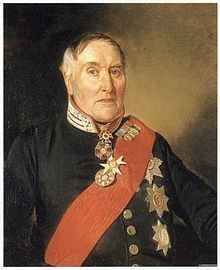 | ||
Notable awards Russian EmpireOrder of Saint Vladimir 2nd Class (1812)Order of St. Anna 1st Class (1814, since 1821 with diamonds)Order of Saint Alexander Nevsky 3rd Class (1828, since 1838 with diamonds)Order of Saint Vladimir 1st Class (1840)AustriaOrder of Leopold 2nd ClassBavariaMerit Order of the Bavarian Crown, CommanderFranceLegion of Honour, Chevalier (1807 or 1809)PrussiaOrder of the Red Eagle, 2nd class (1835)WürttembergOrder of the Crown Fields Surgery, Military medicine | ||
Sir James Wylie, 1st Baronet, in Russia Yakov Vasilyevich Wylie (Russian: Я́ков Васи́льевич Ви́ллие) (13 or 20 November 1768, Kincardine-on-Forth — 2 March 1854, Saint Petersburg), was a Scottish doctor, Russian Imperial Court surgeon in 1799 — 1854 and President of the Imperial Medical and Surgical Academy in 1808 — 1838. He is considered one of the organizers of military medicine in Russia.
Contents
Biography
James Wylie was born on 13 or 20 November 1768 in Tulliallan by Kincardine-on-Forth, Scotland. He was the second of five children of a priest William Wylie and his wife Janet Meiklejohn. After leaving school Wylie was apprenticed to the local doctor. In 1786 he matriculated at Edinburgh University, but received the degree of Doctor of Medicine from King's College, Aberdeen, only in 1794.
In 1790 Wylie was invited to Russia by Dr. John Rogerson (1740—1828), a court physician to Catherine the Great. He entered the Russian service as senior surgeon in the Eletsky Infantry Regiment. Wylie participated in the Polish–Russian War of 1792 and in military operations against the Kościuszko Uprising, culminated in the Battle of Praga. In 1794 he was promoted to staff surgeon.
Retired after the end of the war, Wylie practiced in Saint Petersburg. His reputation grew quickly. Successful operations on Danish ambassador, Baron Otto von Bloom, and later on Count Ivan Kutaisov, the Tsar's closest confidant, made him Surgeon-in-Ordinary to Paul I in 1799. When Paul I was murdered on 23 March 1801, Wylie embalmed the body and gave a certificate that the cause of death was apoplexy.
In 1804 Alexander I invited Wylie back to military service as Medical Inspector of the Imperial Guard. On 2 December 1805 he accompanied the Tsar during the Battle of Austerlitz. In 1808 Wylie was elected President of the Imperial Medical and Surgical Academy in Saint Petersburg.
Wylie was appointed Inspector General for the Army Board of Health in 1806, and became Director of the Medical Department of the Imperial Ministry of War in 1812. On 7 September 1812 at Borodino he performed about 80 operations on the field. He also attended the mortally wounded General Prince Pyotr Bagration, Commander-in-Chief of the 2nd Russian army. On 27 August 1813 at Dresden he amputated the mortally wounded General Moreau's legs, which were shattered by a cannon shot as he was talking to the Tsar.
Wylie accompanied Alexander I during his visit to England in 1814, and was knighted by the Prince Regent. On 2 July 1814, at the special request of the Tsar, Whylie was created a baronet in the name and on behalf of George III. On 2 February 1824 his title was recognized by the State Council of the Russian Empire, making him the unique baronet in the country's history.
Sir James Wylie attended Alexander I at the Congress of Verona in 1822, and was with the Tsar during his last tour to the South of Russia, ended by his death at Taganrog on 1 December 1825.
The Scottish doctor continued to enjoy imperial confidence under Alexander's brother and successor Nicholas I. In general during the Napoleonic wars and the Russo-Turkish war of 1828 — 1829 Wylie took part in more than 50 battles. In 1841 he was promoted to the rank of Actual Privy Councilor (II grade of the Table of Ranks).
Sir James Wylie died at Saint Petersburg on 2 March 1854 and was buried at the Volkovo Lutheran Cemetery.
Contribution to Russia's military medicine
«...During the Napoleonic Wars in 1812, Russian military doctors worked as a coherent system, with a high level of organization in evacuating wounded from the battlefield to field hospitals for operation and recuperation. This complex mechanism was set up by a Scot, James Wylie, who came to live in Russia in the late 1700s and was named physician to the Tsar’s household. Wylie made it a personal goal to ensure that enlisted men as well as officers received medical treatment for wounds instead of being left to die on the battlefield. Through concerted efforts, the number of non-combat losses in peace time in the Russian army fell to ten percent by the mid-19th century. A huge drop in today’s terms, this was an even greater achievement in an era when every fourth European soldier died of disease».
Sir James Wylie also published a number of works on field surgery, pharmacopoeia, contageious diseases, cholera and plague.
In 1823 Sir James Wylie, being Director of the Medical Department, started the Voenno-Meditsinskii Zhurnal (Journal of Military Medicine), Russia's major military medical periodic publication. Nowadays it is the oldest Russian peer reviewed scientific journal.
Russian Empire
Austria
Bavaria
France
Prussia
Württemberg
Memory
Having no children, he bequeathed a considerable fortune of 1,5 million rubles or the construction of a hospital attached to the Imperial Medical and Surgical Academy. The ensemble of its five buildings was finished in 1873. Before the October Revolution of 1917 it was known as the Mikhailovskaya Baronet Wylie Clinical Hospital. Nowadays the former hospital hosts several departments of the S.M. Kirov Military Medical Academy.
A monument to Sir James Wylie designed by architect Andrei Stakenschneider and sculptor David Jensen was erected in 1859 in front of the main building the Medical and Surgical Academy in Saint Petersburg. In 1949 — 1951 by decision of the S.M. Kirov Military Medical Academy headship it was removed to the courtyard of the former Clinical Hospital built with Wylie's funds.
Wylie was depicted by Leo Tolstoy as a character in his epic novel «War and Peace».
